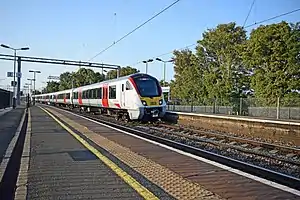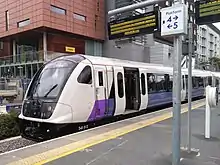Bombardier Aventra
The Bombardier Aventra is a British family of electric multiple unit (EMU) passenger trains designed by Bombardier Transportation, as a successor to the Bombardier Electrostar. It incorporates a large proportion of its design from the latter family, while also including numerous new technologies and achieving compliance with more stringent requirements and operator demands.
| Bombardier Aventra | |
|---|---|
 Class 345 for Elizabeth Line services. | |
| Manufacturer | Bombardier Transportation |
| Built at | Derby Litchurch Lane Works |
| Replaced | |
| Constructed | 2015 – present |
| Predecessor | Bombardier Electrostar |
| Operator(s) | |
| Depot(s) | |
| Specifications | |
| Weight | 30–35 tonnes (30–34 long tons; 33–39 short tons) per car[1] |
| Electric system(s) |
|
| Current collection method | Pantograph, Contact shoe |
| Bogies | Flexx-Eco[2] |
| Track gauge | 1,435 mm (4 ft 8 1⁄2 in) standard gauge |
Bombardier begun developing the Aventra in 2009 based on feedback from train operating companies (TOCs) and upcoming regulation changes. It has been designed to provide a generic platform for conducting inter-regional, commuter, metro, and high-speed passenger services.[3] It has been claimed to be more efficient and flexible than the Electrostar, which was mainly achieved via the greater use of digital technology. The first order for the Aventra came from the Crossrail programme. Numerous other operators have since ordered the type, including London Overground, Greater Anglia, South Western Railway, c2c, and West Midlands Trains. The development of a bi-mode version of the Aventra, incorporating batteries, has also been proposed by Bombardier as a replacement for existing diesel multiple-units.
Description
The Aventra was developed by Bombardier Transportation principally as a successor to their prolific Electrostar electric multiple unit (EMU) family, the final example of which having been delivered during 2018 after nearly twenty years of continuous production.[3] According to Neil Simmons, Bombardier's Head of Bids Engineering, development work on what would become the Aventra had commenced as early as 2009, although its design had significantly evolved during this time.[3] Its design was heavily influenced by feedback gathered from various train operating companies (TOCs), which determined the necessity of such a platform being readily adaptable to serve various subsections of the passenger rail market, including inter-regional, commuter, metro, and high-speed services.[3] Furthermore, the introduction of increasingly stringent regulations had driven a need to either extensively redesign the Electrostar, or to develop a replacement family. Bombardier have reportedly invested in excess of £50 million into the development of the Aventra.[3]
In comparison with the Electrostar, the Aventra has been designed to be lighter, more energy efficient, and with greater flexibility.[3] It has also been claimed to provide greater levels of comfort and reliability.[4] The majority of the mechanical engineering between the two families remains identical, Bombardier having chosen to incorporate many of the Electrostar's refined systems where there was no meaningful improvement to be gained from changing.[3] Amongst the differences in the design are various measures that have been incorporated to achieve superior operational efficiency, including the adoption of wider gangways and doors to shorten station dwell times by speeding up passenger boarding; the gangway has reportedly been designed to allow maximum use of the interior space and ease of movement throughout the train.[5][6] The Aventra features a fully redesigned interior, which Bombardier have indicated to be the main visual difference between the two platforms.[3]
A major area of divergence between the two platforms is the greater use of digital technology onboard the Aventra platform.[3] Many of these new technologies and functionality have been included as a result of operator requests, such as the train control management system, the software of which is routinely updated with the latest improvements.[3] It incorporates a wide range of monitoring sensors to facilitate the extensive use of predictive maintenance techniques, which had proven to be cheaper and yield better results than traditional prescriptive maintenance. Far more reporting information spanning more functionality is generated by the Aventra than on the previous Electrostar family.[3] It also incorporates modern signalling apparatus which, amongst other capabilities, supports the European Rail Traffic Management System (ERTMS).[2]
Structurally, the Aventra is relatively lightweight, the body of each carriage having been extensively redeveloped from the Electrostar.[3] It comprises various welded assemblies that attached to one another via bolts. The vehicle also incorporate the FlexxEco bogie, which had previously been used in service on other Bombardier trainsets, such as the Voyager and some of the later-built Turbostars.[7] While the older Electrostar family are not compliant with the Technical Standards of Interoperability (TSI) implemented in 2017, the Aventra was specifically designed for compliance with the more rigorous regulatory requirements.[3]
During 2018, Bombardier promoted the prospective development of a bi-mode version of the Aventra; it is intended to be capable of speeds up to 125 miles per hour (200 km/h). This bi-mode trainset, which may incorporate batteries would be a potential successor to several older diesel multiple-units, such as the Bombardier Turbostar and Voyager platforms.[8]
The primary manufacturing site for the Aventra has been established at Bombardier's Derby facility; Simmons has stated that the Derby production line is intended to manufacture the type not only to fulfil British orders but also those placed by overseas operators.[3] Each operator can choose to customise the design of their Aventra fleet; common variations have included different vehicle lengths, modified propulsion systems, and interior changes. Much of the onboard equipment has been designed to be flexible and upgradable. Some customers, such as the London Overground, have intentionally stylised their Aventra's interiors to maintain a high degree of commonality with their existing Electrostar fleets.[3]
Orders
As of December 2017, 2,618 vehicles have been ordered for six operators:
Crossrail
The first order for the Aventra platform was a £1 billion contract to supply 65 Class 345 nine-car EMUs (with an option for 17 more) for the London Crossrail programme.[3] These will be operated by Crossrail concession holder MTR Crossrail.[9] In July 2017, it was announced that the order would be increased to 70 trains;[10] the contract for the additional trains was signed in March 2018.[11]
London Overground
London Overground has ordered 54 four-car trains (Class 710), with an option remaining for 15 more, similar to those being used for Crossrail. They will replace Class 315, 317 and 172 on Lea Valley and Gospel Oak lines and will be operated by London Overground concession holder Arriva Rail London.[12]
Greater Anglia


In August 2016, Greater Anglia was awarded the new East Anglia franchise, and announced an order with Bombardier for Class 720 units, formed of 22 ten-car trains and 89 five-car trains (665 carriages) as part of a full fleet replacement programme. Due to the fleet change Greater Anglia has now changed the fleet cancelling 22 X 10 cars (720/1) to 133 x 5 cars but the unit numbers are not confirmed with more of the 720/5.[13]
South Western Railway
On 20 June 2017, Bombardier was awarded a contract to build 750 cars for South Western Railway (SWR). The Class 701 units will be formed into 30 five-car and 60 ten-car sets and replace the entirety of the 455, 456, 458 and 707 suburban fleet currently used by SWR.[14][15]
West Midlands Trains
On 17 October 2017, Bombardier was selected to provide a total of 81 Class 730 EMU vehicles (333 carriages) for West Midlands Trains. These will be formed into three separate types; 36 three-car high capacity 'Metro' units, 29 five-car units for outer suburban services, and 16 five-car units for London-Birmingham services.[16]
Bombardier Aventra variants
| Class | Operator | Introduced | Number | Power | Carriages | Carriage Length (m) | Door configuration | End gangways | Image |
|---|---|---|---|---|---|---|---|---|---|
| Class 345 | TfL Rail | 2017 | 70 | AC electric | 9 (7 from 2017) | 24 | Plug, 6 sets of doors per carriage | No |  |
| Class 701 | South Western Railway | 2021 | 30 | DC electric | 5 | 20 | Plug, 4 sets of doors per carriage | ||
| 60 | 10 | ||||||||
| Class 710 | London Overground | 2019 | 31 | AC electric | 4 | 20 |  | ||
| 18 | Dual voltage | ||||||||
| 6 | 5 | ||||||||
| Class 720[20] | c2c | 2021 | 6 | AC electric | 10 | 24 |  | ||
| Greater Anglia | 2020 | 133 | 5[21] | ||||||
| Class 730 | West Midlands Trains | 2020 | 36 | AC electric | 3 | 24 | Yes | ||
| 2021 | 29 | 5 | |||||||
| 16 | |||||||||
References
- "Weight-loss drives step-change". The Rail Engineer (October 2009). Archived from the original on 22 February 2013.
- Bednall, Joe (June 2010). "A low impact commuter train". Rail Professional (159). p. 27.
- Clinnick, Richard (28 January 2018). "From the archives: Mind the generation gap". railmagazine.com.
- "Aventra – Proven Innovation". The Rail Engineer (60): 17–19. October 2009.
- "The customer is king". The Rail Engineer (65). March 2010. pp. 28–29.
- Bedminster, Paula (December 2009). "The lightweight Aventra" (PDF). Rail Professional (153). pp. 8–9. Archived from the original (PDF) on 6 March 2012.
- "Bombardier's Aventra – A new era in train performance". www.rail.co. 21 March 2011. Archived from the original on 20 March 2012.
- "Bombardier bi-mode Aventra to feature battery power". Rail Magazine. 29 March 2018. Retrieved 5 April 2018.
- "Bombardier wins Crossrail train contract". Railway Gazette International. London. 6 February 2014.
- "TfL to order more Elizabeth line trains". Global Rail News. 13 July 2017. Retrieved 15 September 2018.
- "More Crossrail trains ordered". Metro Report International. 27 March 2018. Archived from the original on 16 September 2018. Retrieved 15 September 2018.
- Sadler, Katie (3 July 2015). "Bombardier to supply and maintain 180 AVENTRA vehicles for London Overground". European Railway Review. Retrieved 15 September 2015.
- Barrow, Keith (10 August 2016). "Abellio clinches East Anglia franchise". International Railway Journal. Retrieved 10 August 2016.
- Johnson, Robin (20 June 2017). "Derby's Bombardier lands South West Trains order worth almost £900 million". Derby Telegraph. Retrieved 20 June 2017.
- "FirstGroup and MTR order 750 EMU cars for South Western franchise". International Railway Journal. 20 June 2017.
- "Bombardier and CAF win West Midlands train contracts". Railway Gazette. 17 October 2017. Retrieved 17 October 2017.
- "Bombardier to supply Aventra EMUs to c2c". Railway Gazette. 14 December 2017. Retrieved 14 December 2017.
- Briginshaw, David (14 December 2017). "Britain's c2c franchise orders Aventra EMUs". International Railway Journal. Retrieved 14 December 2017.
- "New trains boost to deal with 'unprecedented' demand". Railnews. 13 April 2016. Retrieved 14 December 2017.
- https://uk.linkedin.com/in/james-o-sullivan-05ba857b
- "New trains as Abellio scoops East Anglia franchise". www.railmagazine.com.